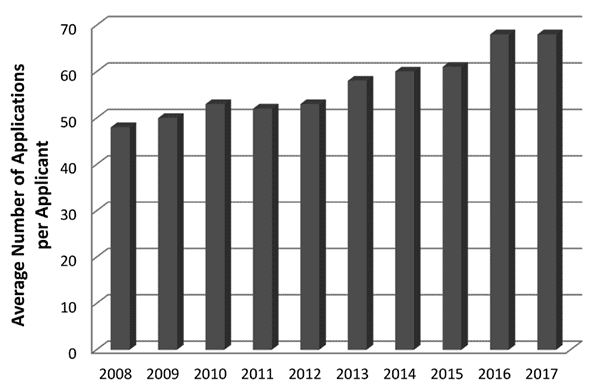Choosing Ophthalmology Programs
Selecting the programs to which you should send your application can be a daunting task. There are currently between 110 and 120 ophthalmology residency programs in the country (search FREIDA for a complete list or see see https://residency.doximity.com/specialties/50-ophthalmology). If you can specify your search to a specific geographic region, that will narrow the options considerably. However, this may not be possible as the best programs are sprinkled across the country. There are a variety of websites providing information on programs, but you must take this with a grain of salt because there is no way to be certain who is writing the reviews. Some of these sites include the Residency Compendium thread at Student Doctor Network (which is moderated by Dr. Doan who completed his residency at Iowa), Scutwork, and MatchApplicants among others. You can also use Google to find departmental websites and these are usually fairly helpful. The Ophthalmology Times previously ranked departments annually and they also specifically provided rankings for residency programs. They no longer perform these rankings, but the most recent results from 2010 are displayed below (Table 1) (4). These may not be entirely accurate anymore as some of these programs have undergone significant changes such as that acquisition of the Doheny Eye Institute by UCLA.
Best Overall
|
Best Research
|
Best Residency
|
Best Clinical (Patient Care) Programs
|
U.S. News & World Report continues to rate ophthalmology clinics annually, but does not specifically rank residency programs (Table 2). Nobody knows exactly how reliable these rankings are, and while the exact order is often debated, any program appearing in the "top 10" is generally highly regarded. They are now integrating physician votes from the physician social media website Doximity.com into their rankings. Hopefully they will find a way to maintain some degree of objectivity in the rankings rather than turning them into a popularity contest.
2017 U.S. News & World Report Ophthalmology Rankings |
|
You can mine out a fair amount of information on your own, but the best resources, by far, are faculty members, residents, and fellows in the department. Ophthalmology is a relatively small field and there is a good chance these people have colleagues and friends at other institutions. This provides wonderful insight that rankings will not specify, such as whether the atmosphere is "malignant," if residents seem happy, and how prepared residents are after graduation. They may also know of upcoming changes to a program that may not otherwise be advertised during the interview process. Ask your mentor(s) if you can meet to discuss your application and suitable programs for the strength of your application. At Iowa, Dr. Tom Oetting and Dr. Pavlina Kemp are always happy to meet with students for this purpose.
There is good reason to meet with a knowledgeable person who is able to match your application strength with the programs to which you should apply. The residency match works differently than applying to college where you could apply to safety schools and know you would be accepted. Residency programs take pride in matching applicants at the top of their rank lists. If you are a super-applicant, a lower-tier residency program may not rank you highly or even interview you because they know you are not going to end up at their program. They often prefer to use their top ranking positions on applicants whom they think will end up at their program so they match higher on their list. It sounds silly, but it's the way the match system works. To summarize, applying to lower-tier schools with a competitive application may not net you many interviews in the same way that applying to competitive schools with a weak application won't. You want to diversify between program strength to a certain extent, but your program list needs to be matched to your application strength.
Another consideration is whether you intend to go into private practice or academics. Some programs are more well-known for research and producing academic physicians while others are more tailored toward training comprehensive ophthalmologists going into private practice. There is a section of your application asking what your aspirations are as a future physician. Putting academics in this section should not limit your interview offers, but putting private practice may turn off some of the more academic programs. For this reason, I would recommend leaning toward academics for interview purposes.
There is no set number of programs that is right for everyone and the majority of applicants end up applying to many more than they should. In 2017, the average applicant applied to 70 programs, a number that continues to rise each year (Figure 3) (1). SF Match charges an incremental application fee depending on how many programs you wish to apply and this is a good reason to limit your number. Depending on your competitiveness, the sweet spot as a compromise between cost and safety is in the 30's. Beyond 40, the fee increases to $35 per additional program. If your application is less competitive, however, it is a worthwhile investment to apply to many programs to increase your odds of receiving a sufficient number of interview offers.

Figure 3. Average number of ophthalmology residency applications submitted per applicant (1). See the full report
Choosing Programs for Intern Year
A few ophthalmology programs in the country, including the University of Iowa, now have integrated intern years. This is a tremendous advantage in a variety of ways. If you schedule your internship interviews after Ophthalmology Match Day, you can save a huge amount of time and money by canceling all of these interviews if you happen to match at one of these programs. You can also potentially eliminate one move (which can cost thousands of dollars) since you'll be at the same location for both components of your residency training. In terms of education, you will have an entire year to familiarize yourself with the location, hospital systems, and electronic medical record, prior to starting residency. Meeting individuals in other departments is useful as you will be interacting with these people during consultations as an ophthalmology resident during your next 3 years. Finally, and most importantly, you will receive additional ophthalmology training during your intern year which you would not otherwise receive in the more traditional internships. At the University of Iowa, interns receive 5 months of ophthalmology training during their internship prior to beginning residency and taking their first day of ophthalmology call. This is invaluable.
If you match at one of the majority of programs that still does not have an integrated internship, you have the choice of completing a transitional year, a prelim year in internal medicine, or a prelim year in general surgery. In general, transitional years are more desirable as they offer a more diverse experience and require less work hours. That being said, transitional years can be extremely competitive and are not available at all institutions.
People have varying opinions on where to do their intern year. Some view it as an opportunity to travel to an exotic destination for a year before returning for their ophthalmology residency. Others want to minimize the number of times they are required to move and they look in either the city of their medical school or the city of their future residency program. Unlike other applicants for transitional and prelim years, as an ophthalmology applicant you will have the advantage of knowing where you matched for residency before having to submit your rank list due to the early match.
It can be much more difficult to find information on transitional and prelim programs than their ophthalmology counterparts. The best source for information on these programs is by word of mouth. Talk with M4's who have finished interviewing or current residents in fields requiring a separate intern year. Past program reviews can be found on various message boards across the internet, but with the change in intern duty-hours requirements in 2011, all programs have had to redesign the way their residents take night float and call. Until newer reviews are posted, it will be difficult to know which programs are now "cush" and which have forsaken their coveted "cush" reputation.
The optimum number of applications for intern year varies widely depending on who you ask. I've talked to residents who only applied to 1 and others who applied to 30. I think anywhere from 10-15 is generally appropriate.


